Chapter 12: Coordination and Response in Humans
What you need to learn in this chapter

In this chapter, we will learn about coordination and response in humans. We will understand the sequence and components involved in human coordination, such as stimulus, receptor, integration centre, effector, and response. We will also identify and describe both external and internal stimuli. Next, we will study the nervous system and explain the structures of the human nervous system, including the central nervous system (brain and spinal cord) and the peripheral nervous system (sensory receptor, cranial nerve, and spinal nerve). We will also learn about the functions of different parts of the central nervous system related to coordination and response, such as the cerebrum, cerebellum, medulla oblongata, hypothalamus, and pituitary gland. Moving on, we will explore neurones and synapses by drawing and label the structures of a sensory neurone and a motor neurone, including dendrites, axons, cell bodies, myelin sheaths, and nodes of Ranvier. We will analyze the functions of each type of neurone in impulse transmission. Lastly, we will compare and contrast voluntary and involuntary actions. We will describe reflex actions involving two neurones and three neurones. By the end of this chapter, we will have a solid understanding of coordination and response in humans, the nervous system, neurones and synapses, and voluntary and involuntary actions.
Topics in this chapter
What you will learn in this topic
- Make a sequence and describe components in human coordination: (i) stimulus. (ii) receptor. (iii) integration centre. (iv) effector. (v) response
- Identify and describe external and internal stimuli
- List the types of sensory receptors based on the stimuli involved: (i) chemoreceptor. (ii) mechanoreceptor. (iii) photoreceptor. (iv) thermoreceptor. (v) baroreceptor. (vi) nocirecepto
- Justify the necessity to respond to external and internal stimuli
What you will learn in this topic
- Construct an organisational chart and explain the structures of the human nervous system: (i) central nervous system - brain - spinal cord (i) peripheral nervous system - sensory receptor - cranial nerve - spinal nerve
- Explain the functions of parts of in the central nervous system related to coordination and response. (i) brain - cerebrum - cerebellum - medulla oblongata - hypotalamus - pituitary gland (ii) spinal cord
- Communicate about the functions of parts of the peripheral nervous system in coordination and response
What you will learn in this topic
- Draw and label structures of a sensory neurone and a motor neurone: (i) dendrite. (ii) axon. (iii) cell body . (iv) myelin sheath. (v) node of Ranvier.
- Analyse the functions of each type of neurone in impulse transmission
- Explain the structure and function of synapse
- Explain the transmission of impulse across a synapse
What you will learn in this topic
- Compare and contrast voluntary and involuntary actions
- Describe the reflex actions involving: (i) two neurones. (ii) three neurones
- Draw a reflex arc
What you will learn in this topic
- Communicate about the health issues related to the nervous system
- Describe the effects of drug and alcohol abuse on human coordination and response
What you will learn in this topic
- State the role of endocrine glands in human
- Identify and label the endocrine glands in humans
- Analyse the functions of hormones secreted by each endocrine glands: (i) hypothalamus - gonadotropin releasing hormone (GnRH) (ii) anterior lobe of pituitary - growth hormone (GH) - follicle stimulating hormone (FSH) - luteinising hormone (LH) - thyroid stimulating hormone (TSH) - adrenocorticotropic hormone (ACTH) (iii) posterior lobe of pituitary - oxytocin hormone - antidiuretic hormone (ADH) (iv)thyroid - thyroxine hormone (v) pancreas - insulin hormone - glucagon hormone
- Discuss involvements of the nervous system and endocrine system in a “fight or flight” situation
- Compare and contrast the nervous and the endocrine system
What you will learn in this topic
- Predict the effects of hormonal imbalances on human health

Live class daily with celebrity tutors
Learn more »
